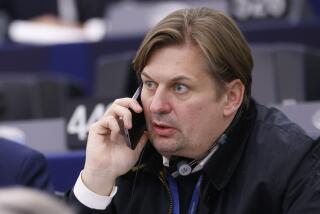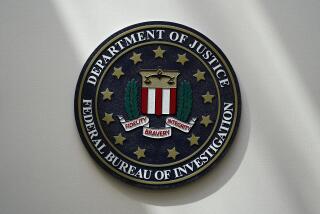Trail of Alleged Bloch Spymaster Picked Up
- Share via
VIENNA — In a potentially explosive development in the Felix S. Bloch espionage investigation, the Austrian government announced Friday that a suspected KGB agent believed to have been Bloch’s principal contact traveled frequently to Austria on a forged Finnish passport during the seven years the American diplomat served in the U.S. Embassy here.
The suspected Soviet spymaster, a man in his 60s who had posed as the representative of a Finnish computer firm, has not been seen here since he left the country en route to Helsinki in early June, the authorities reported.
U.S. Provided Photos
In disclosing the results of a monthlong probe into the Bloch affair, the Austrians indicated they had tracked down the mysterious man after the United States provided them with photographs showing the two men together.
Austrian security chief Robert Danzinger told reporters at a crowded briefing that the government had no doubt that it had identified the suspected Soviet agent sought by American authorities in the case.
“Our investigations have turned up a man who apparently had contacts with Bloch,” Danzinger said. “We have to assume that he was working for the KGB.”
But Danzinger said that the initial police information about the apparent spymaster had come “solely from Washington.”
The revelation about the shadowy character of Bloch’s associate adds the first independent evidence to support the suspicions of U.S. authorities that Bloch lived a secret life as a Soviet agent while serving as a high-ranking American diplomat in Austria.
Another indication of a double life came as police confirmed that they had interviewed an Austrian woman in her 30s with whom they said Bloch, who was married, had maintained a relationship. The authorities refused to identify the woman, saying they had no indication that she had any link to the suspected KGB agent or was involved in espionage in any way.
Newspaper accounts, citing anonymous sources, have described the woman as a high-class call girl who was vacationing in Egypt. The police refused to say whether she is a prostitute but confirmed that she had indeed been in Egypt until earlier this week.
In providing the freshest leads to date in the Bloch case, the Austrian officials stressed that they had no direct knowledge of spying activities by either Bloch or his suspected Soviet contact and said they regarded the investigation as entirely an American affair.
“It is now up to the Americans to prove that this was an espionage relationship,” declared Interior Minister Franz Loschnak.
No evidence has been found to show that Austrian interests were harmed by the episode, Loschnak said. He added, however, that the case of the mysterious Finnish passport-holder would be turned over to Austrian prosecutors, presumably to determine whether immigration laws were violated.
The passport, issued in 1979 by the Finnish Embassy in Vienna, provided the suspected Soviet agent with easy entree into Austria for nearly 10 years, the officials reported.
They said he traveled to Vienna frequently during that period, usually remaining each time for stays of a few weeks or a month. In recent years, he generally shared the “moderate” apartment of an Austrian woman friend in her 40s.
Neither the woman friend nor anyone else apparently found reason to question the man’s assertion that he represented a Finnish computer company and had a relationship with IBM, the police said. Not until they tried to track down the man whose face appeared on photos vital to the Bloch investigation did they learn that no one with his name existed in Finland, and that no one matching his description was employed by the Finnish firm.
The Austrian authorities said they began their investigation into the Bloch matter on June 23, a day after the diplomat was placed on administrative leave from his job in the State Department’s Bureau of European and Canadian Affairs.
At that time, the United States provided only the sketchiest details. “We didn’t know who it was supposed to be,” Loschnak complained.
Not until early July did U.S. authorities name Bloch as the diplomat under investigation, the official said.
The authorities did not directly indicate how they obtained the photographs with which they identified Bloch’s suspected Soviet contact.
It seemed most likely that the photos were produced from a videotape obtained by U.S. intelligence agencies that shows Bloch passing a briefcase to another man in Paris earlier this year.
The discomfort felt by the neutral Austrian government at its peripheral involvement in the East-West espionage investigation was evident in the tone taken by its officials during Friday’s announcement.
The revelations about Bloch came only after a 90-minute report on the status of an investigation into attacks by Kurdish terrorists, and even then, officials had to be prompted to discuss the espionage case.
At the briefing, Loschnak confirmed for the first time that the FBI asked the government last week for permission to put questions to 10 known Austrian associates of Bloch.
But officials stressed that the two governments maintained no agreement to cooperate in such investigations.
More to Read
Sign up for Essential California
The most important California stories and recommendations in your inbox every morning.
You may occasionally receive promotional content from the Los Angeles Times.










